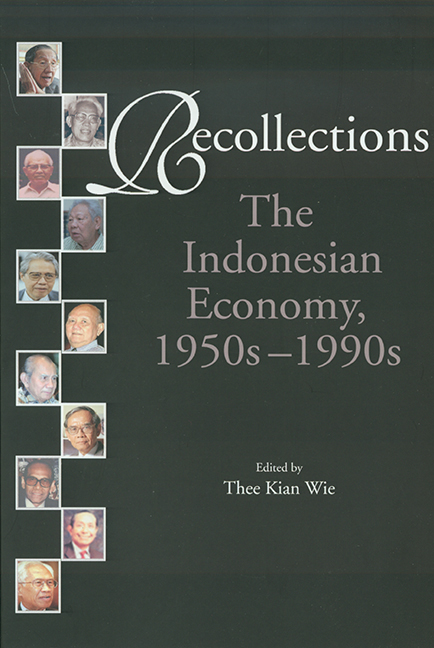Book contents
- Frontmatter
- Dedication
- Contents
- Foreword
- Preface
- Acknowledgments
- Introduction
- II Recollections
- 1 Sumitro Djojohadikusumo
- 2 Mohammad Saubari
- 3 Sjafruddin Prawiranegara
- 4 Abdoel Raoef Soehoed
- 5 Sarbini Sumawinata
- 6 Mohammad Sadli
- 7 Soedarpo Sastrosatomo
- 8 Suhadi Mangkusuwondo
- 9 Emil Salim
- 10 Subroto
- 11 Teuku Mohamad Daud
- Index
- About the Editor
10 - Subroto
from II - Recollections
Published online by Cambridge University Press: 21 October 2015
- Frontmatter
- Dedication
- Contents
- Foreword
- Preface
- Acknowledgments
- Introduction
- II Recollections
- 1 Sumitro Djojohadikusumo
- 2 Mohammad Saubari
- 3 Sjafruddin Prawiranegara
- 4 Abdoel Raoef Soehoed
- 5 Sarbini Sumawinata
- 6 Mohammad Sadli
- 7 Soedarpo Sastrosatomo
- 8 Suhadi Mangkusuwondo
- 9 Emil Salim
- 10 Subroto
- 11 Teuku Mohamad Daud
- Index
- About the Editor
Summary
FAMILY BACKGROUND AND EARLY YOUTH
I was born on 19 September 1928 in Solo, a son of Bapak Sinduredjo, a civil servant at the court of the Sunan of Surakarta, and later a bupati (district head). I was raised in religious surroundings, as both my father and mother were activists in Muhammadiyah, the moderate modernist Muslim organisation. At a young age I joined Hisbulwathon, the boy scout movement of Muhammadiyah. Hisbulwathon means the ‘army of Allah’, and its slogan was ‘Fastabikulkhairot’ — ‘compete in doing good things’. This value of ‘giving service’ greatly influenced me in later life. It was stressed by both my father and my mother. In Indonesian philosophy it is called dharma — doing something for the community (masyarakat).
As my father was an official of Sunan Paku Buwono X, who was considered the last great Sunan of Surakarta, I was enrolled at the local Dutch–Indonesian primary school (HIS). Here I was taught Dutch as well as Javanese, the major medium of instruction.
After graduating from the HIS I continued my Dutch education at the MULO (Meer Uitgebreid Lager Onderwijs), a junior high school in Solo which provided more elaborate three-year instruction in the courses already offered in primary school. Those more fortunate, for example, Professor Sadli, entered the HBS (Hogere Burgerschool, Higher Civilian School) which, in terms of intellectual thoroughness, gave a better education than the MULO. I was in the second year of the MULO when the Pacific War broke out.
After the Japanese army had occupied Solo in early 1942 they established the SMP, Sekolah Menengah Pertama (First Level Secondary School), a Japanese version of the MULO. I continued my secondary education at an SMP in a neighbourhood known during the Dutch colonial period as Villapark, but now called Banjarsari. Here we were taught Japanese, which I managed to learn rather well.
After graduating from the SMP in 1944, I went to Yogyakarta to attend the SMT (Sekolah Menengah Tinggi, Higher Secondary School), which after independence became the SMA (Sekolah Menengah Atas, Senior Secondary School)).
- Type
- Chapter
- Information
- RecollectionsThe Indonesian Economy, 1950s–1990s, pp. 221 - 250Publisher: ISEAS–Yusof Ishak InstitutePrint publication year: 2003

